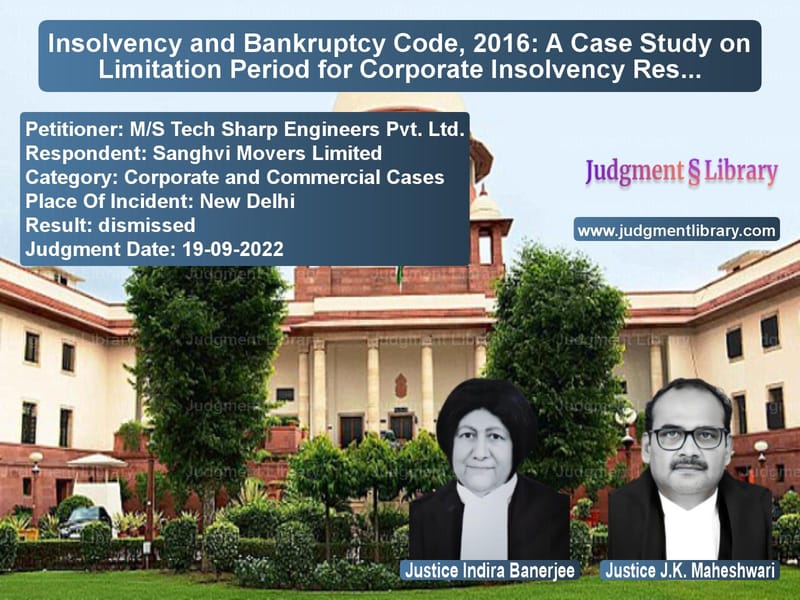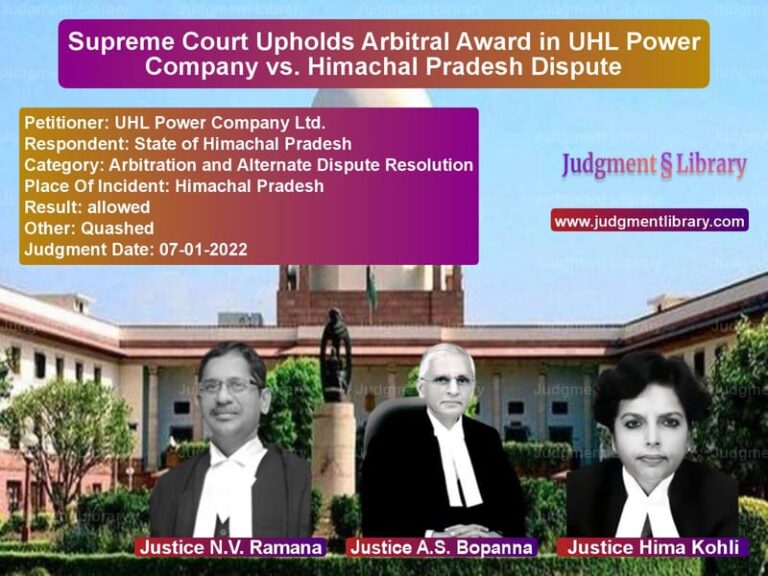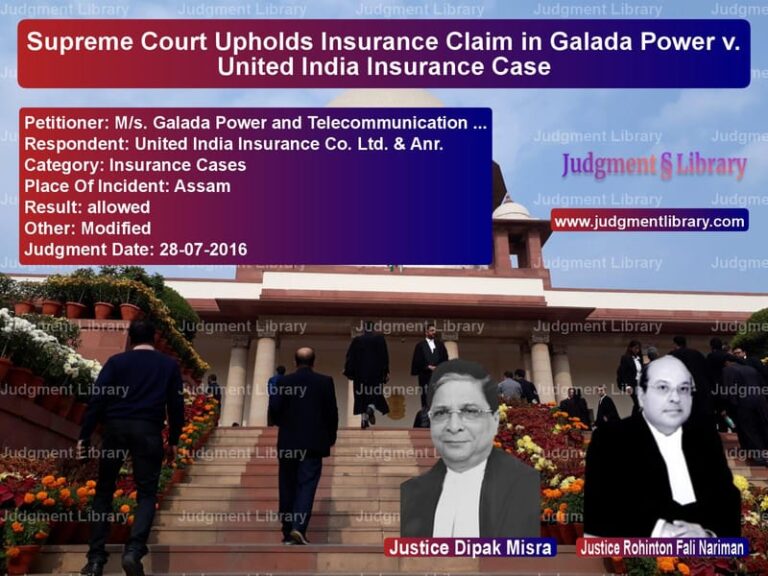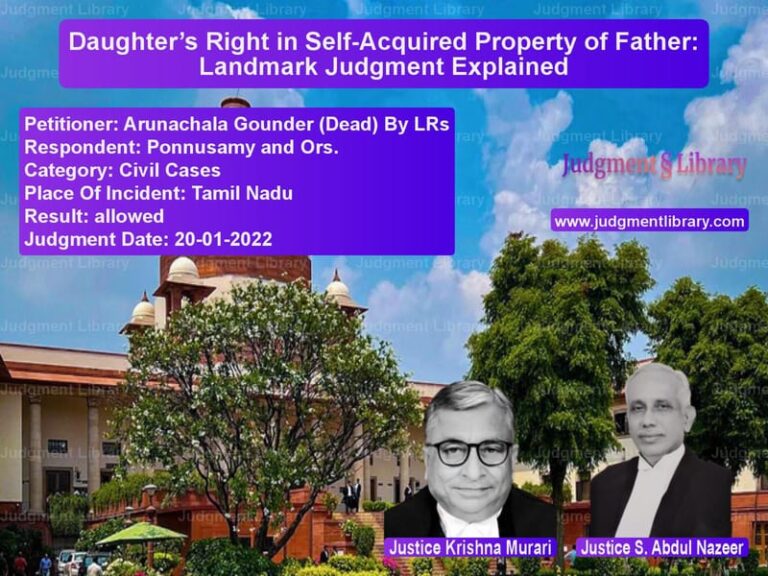Insolvency and Bankruptcy Code, 2016: A Case Study on Limitation Period for Corporate Insolvency Resolution Process
The case of M/S Tech Sharp Engineers Pvt. Ltd. v. Sanghvi Movers Limited revolves around the interpretation of the limitation period for the initiation of Corporate Insolvency Resolution Process (CIRP) under the Insolvency and Bankruptcy Code (IBC), 2016. The respondent, Sanghvi Movers Limited, filed an application under Section 9 of the IBC to initiate CIRP against the appellant, M/S Tech Sharp Engineers Pvt. Ltd. for the non-payment of dues. The Adjudicating Authority (NCLT) had initially dismissed the application on grounds of limitation, relying on the judgment in B.K. Educational Services Pvt. Ltd. v. Parag Gupta and Associates, which determined the limitation period for filing applications under Section 7 and 9 of the IBC. However, the NCLAT overturned this decision and allowed the application, citing that the application was within the three-year limitation period, starting from the date when the right to apply under Section 9 of the IBC arose. This decision was challenged by the appellant in the Supreme Court, which examined the issue of limitation and the right to sue in the context of the IBC.
Background of the Case
The appellant, M/S Tech Sharp Engineers Pvt. Ltd., entered into a contract with Sanghvi Movers Limited for the hire of cranes and equipment for the construction of a project at the Paradip refinery in Odisha. Sanghvi Movers Limited raised several invoices between 2012 and 2013 for a total amount of Rs. 38,84,709. Despite repeated reminders and statutory notices, the appellant failed to settle the dues. In 2013, the respondent initiated winding-up proceedings against the appellant under the Companies Act, 1956, but the petition was delayed. In 2017, when the IBC came into effect, Sanghvi Movers filed an application under Section 9 of the IBC for initiating CIRP against the appellant. The NCLT dismissed the application, claiming that it was barred by limitation. The NCLAT, however, reversed this order, stating that the application was filed within the prescribed limitation period. The Supreme Court was called upon to adjudicate on the issue of limitation for filing applications under the IBC.
Petitioner’s Arguments
The petitioner, M/S Tech Sharp Engineers Pvt. Ltd., made the following arguments in support of their case:
- Limitation Under IBC: The petitioner argued that the application for CIRP was barred by limitation, as the claim was filed after the statutory limitation period of three years. The petitioner cited the Supreme Court’s judgment in B.K. Educational Services Pvt. Ltd. v. Parag Gupta and Associates, which clarified that the limitation period under Article 137 of the Limitation Act applies to applications under Section 7 and 9 of the IBC, and that the right to sue accrues when a default occurs.
- Right to Sue Accrued in 2013: The petitioner claimed that the right to apply under the IBC had accrued in 2013 when the debt became due, and the application for CIRP was filed in 2018, well beyond the three-year limitation period. The petitioner argued that the NCLAT erred in holding that the right to apply under the IBC arose only after the enactment of the IBC in December 2016.
- Impact of Winding-Up Proceedings: The petitioner argued that the pendency of the winding-up petition before the Madras High Court did not stop the limitation period from running. They contended that the respondent could have filed an application under the IBC earlier, but chose to wait until 2017, when the IBC came into force. This delay should not be allowed to excuse the breach of the limitation period.
- Jurisdiction of NCLT: The petitioner also argued that the NCLT did not have jurisdiction to hear the application for CIRP after the expiry of the limitation period. They contended that the NCLT’s jurisdiction is governed by the Limitation Act, and an application filed after the prescribed period cannot be entertained.
Respondent’s Arguments
The respondent, Sanghvi Movers Limited, made the following arguments:
- Right to Apply Under the IBC: The respondent argued that the right to apply under the IBC arose only after the enactment of the IBC in December 2016. The respondent claimed that the limitation period under the Limitation Act did not apply as the IBC was a new framework for insolvency proceedings. The respondent emphasized that the application was filed in 2018, within the three-year limitation period from the date when the right to apply accrued.
- Continuing Cause of Action: The respondent contended that there was a continuing cause of action, as the debt remained unpaid despite repeated reminders. They argued that the limitation period should not be counted from the date the debt first became due but should be measured from the date of the application under the IBC.
- Waiver of Limitation: The respondent argued that the appellant’s failure to raise the limitation defense at the earliest stages of the application amounted to a waiver of the limitation defense. They claimed that the delay in filing the application was due to the pendency of the winding-up petition and should not affect the validity of the CIRP application.
- Public Policy and Justice: The respondent emphasized that the IBC was enacted to resolve insolvency issues and promote the resolution of distressed companies. They argued that limiting the ability to initiate CIRP on technical grounds of limitation would defeat the purpose of the IBC and be contrary to public policy.
The Court’s Reasoning
The Supreme Court, after carefully considering the arguments presented by both parties, made the following observations:
- Applicability of the Limitation Act to IBC: The Court affirmed that the provisions of the Limitation Act are applicable to proceedings under the IBC, especially in cases involving the initiation of CIRP. The Court referenced the B.K. Educational Services Pvt. Ltd. case and explained that the right to sue arises when a default occurs. The Court observed that the limitation period under Article 137 of the Limitation Act applies from the date when the default occurs, not from the date of the enactment of the IBC.
- Continuous Cause of Action: The Court rejected the respondent’s argument of a continuous cause of action. The Court emphasized that the default occurred in 2013, and the limitation period began from that date. The pendency of the winding-up petition did not extend the limitation period for filing an application under the IBC.
- Discretion to Condone Delay: The Court explained that while the NCLT has discretion to condone delay under Section 5 of the Limitation Act, this discretion can only be exercised when there is sufficient cause for the delay. The Court held that the respondent did not provide sufficient cause for the delay in filing the application after the expiration of the limitation period.
- Jurisdiction of NCLT: The Court held that the NCLT’s jurisdiction is determined by the limitation period, and the NCLT could not entertain an application that was barred by limitation. The Court pointed out that the respondent could have filed the application earlier under the old legal framework or under the Companies Act, 1956, but chose to wait until the IBC came into force.
- Enhancement of Legal Certainty: The Court emphasized the importance of adhering to the limitation period as prescribed by the law to ensure legal certainty and prevent unnecessary delays in insolvency proceedings. The Court noted that insolvency proceedings under the IBC must be conducted within the framework of the law and the prescribed timelines.
The Court’s Decision
The Supreme Court made the following orders:
- Dismissal of the Appeal: The Court dismissed the appeal and upheld the decision of the NCLAT. The Court affirmed that the application under Section 9 of the IBC was filed within the three-year limitation period and should not be dismissed on technical grounds of limitation.
- Reinstatement of CIRP Application: The Court directed the NCLT to admit the respondent’s application under Section 9 of the IBC and proceed with the CIRP process in accordance with the law.
- Costs: The Court awarded costs in favor of the respondent for the successful appeal.
Conclusion
This case highlights the importance of adhering to the limitation period for filing applications under the Insolvency and Bankruptcy Code. The Supreme Court’s decision reinforces the need for timely resolution of insolvency proceedings while ensuring that the legal framework surrounding the limitation period is followed. The ruling also emphasizes the need for clarity in determining when the right to apply under the IBC arises and the conditions under which delay in filing can be condoned.
Petitioner Name: M/S Tech Sharp Engineers Pvt. Ltd..Respondent Name: Sanghvi Movers Limited.Judgment By: Justice Indira Banerjee, Justice J.K. Maheshwari.Place Of Incident: New Delhi.Judgment Date: 19-09-2022.
Don’t miss out on the full details! Download the complete judgment in PDF format below and gain valuable insights instantly!
Download Judgment: ms-tech-sharp-engin-vs-sanghvi-movers-limit-supreme-court-of-india-judgment-dated-19-09-2022.pdf
Directly Download Judgment: Directly download this Judgment
See all petitions in Company Law
See all petitions in Bankruptcy and Insolvency
See all petitions in Corporate Compliance
See all petitions in unfair trade practices
See all petitions in Judgment by Indira Banerjee
See all petitions in Judgment by J.K. Maheshwari
See all petitions in dismissed
See all petitions in supreme court of India judgments September 2022
See all petitions in 2022 judgments
See all posts in Corporate and Commercial Cases Category
See all allowed petitions in Corporate and Commercial Cases Category
See all Dismissed petitions in Corporate and Commercial Cases Category
See all partially allowed petitions in Corporate and Commercial Cases Category







